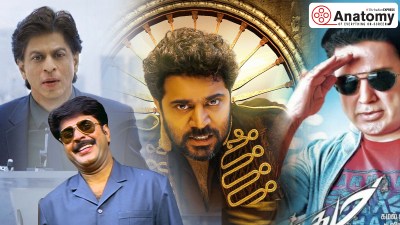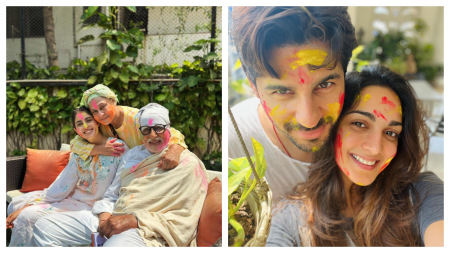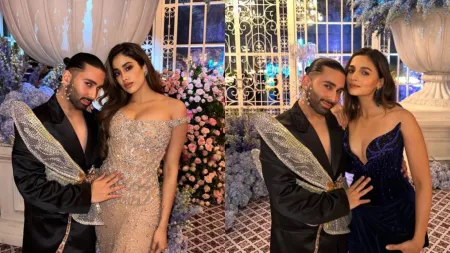- India
- International
Mani Ratnam at 65: Made in Madras, his superb songs enthral all of urban India
The Mani Ratnam-Ilaiyaraaja-AR Rahman combo has created a gold-standard repertoire of Tamil-Hindi film soundtracks. As realistic as Ratnam's films are, his songs are the absolute opposite — illogical, grand and dream-like. Presenting a quick guide to his music.
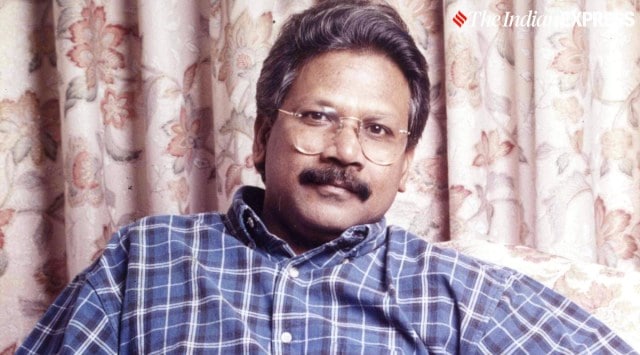 Mani Ratnam turns 65 today. (Express archive photo)
Mani Ratnam turns 65 today. (Express archive photo)Mani Ratnam — ‘Mani Sir’ to the movie industry and fans — turns 65 today. What better way to celebrate his birthday than to plug into the prodigious music and dream-like song situations that his films have given us over the last three decades? With most filmmakers, the ‘action’ is where the action is. In Ratnam’s case, the ‘score’ is where the action is. He’s the ultimate word in song picturisation. Starting with his breakout, Mouna Ragam (1986) that tells the story of a woman (a spunky Revathi) torn between an old flame who’s shot in an unfortunate mishap moments before their court wedding and a husband she doesn’t love to O Kadhal Kanmani (2015) that updates the idea of ‘love’ for the iGeneration that prefers live-in to marriage, Ratnam’s genius is the single-minded ways in which he has put his faith repeatedly in the vagaries of human relationships. “His images sank into our souls,” writes critic Baradwaj Rangan in Conversations with Mani Ratnam describing the imprint his work has had on Kollywood fans like him that came of age in the 1980-90s.
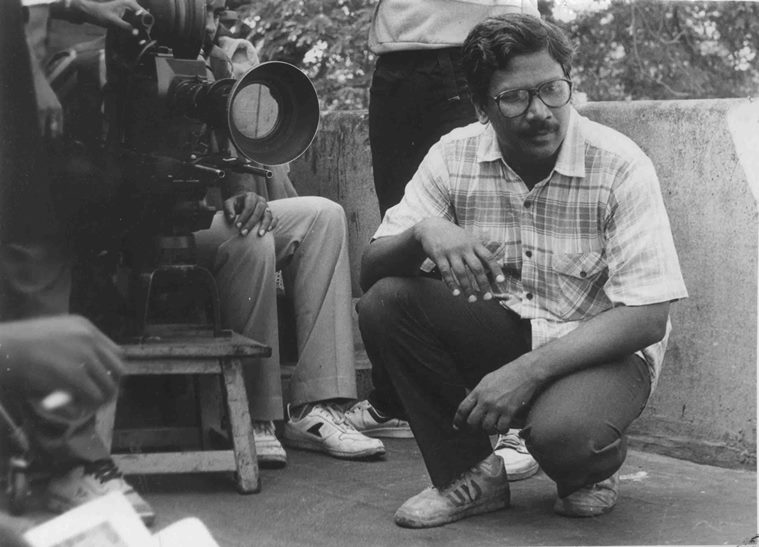 Nobody seeing Mani Ratnam’s songs could tell that they are shot by the same guy who made these films. (Express archive photo)
Nobody seeing Mani Ratnam’s songs could tell that they are shot by the same guy who made these films. (Express archive photo)
All of Ratnam’s 26-odd films as a director, beginning with his debut Pallavi Anu Pallavi in 1983 starring a raw Anil Kapoor and Lakshmi, are adamantly realistic and true-to-life. Rooted in a social milieu instantly familiar to most Indians, they are urban in outlook and take up the delicate nature of life, love and relationships as their subject. Cities like the director’s hometown Chennai, Delhi or Mumbai usually serve as a backdrop. Yet, it is in the songs that Mani Sir lets his imagination run wild. He draws a bold and colourful picture through his distinct brand of songs that somehow fit the context of the film and at the same time, transcend it. You can hum the music without knowing which film it is from.
Nobody seeing Mani Ratnam’s songs could tell that they are shot by the same guy who made these films. His plots have all the requisite ebbs and flows and rich human drama. By comparison, the songs are the exact opposite — grand, carefree, stylised, ambitious and absolutely follow no rulebook. Go back and watch Thalapathi (1991), Roja (1992), Thiruda Thiruda (1993), Bombay (1995), Iruvar (1997), Dil Se.. (1998), Alaipayuthey (2000), Kannathil Muthamittal (2002), Yuva (2004), Guru (2007), Raavan (2010), O Kadhal Kanmani (2015) and his more recent, Kaatru Veliyidai (2017). You will be blown away by the ambience, the imagery and philosophy of the musical interludes that “lets you reach an arc of celebration, whether it is joy or sorrow, whichever emotion,” as the master from Madras put it in a 2015 interview with BFI. After hearing his thoughts in this masterclass it soon becomes evident that in a Mani Ratnam film the song is just a palate cleanser which has come to occupy the glamour of the main dish. Don’t look for logic in them. The man himself justifies his music’s vital magic realism by underlining its abstractions. India’s nonlinear and free-flowing “oral tradition” of storytelling is a constant frame of reference, he admits.
So, is it abstraction alone that has kept ‘Mandram Vandha’, ‘O Priya Priya’, ‘Chilakamma Chitikeyanga,’ ‘Dil hi chhota sa,’ ‘Tu hi re,’ Nayakan’s theme tune ‘Thenpandi Cheemayile’, ‘Snehithane Snehithane,’ ‘Kabhi neem neem’ and even the dance anthem ‘Chhaiyya chaiyya’ so timeless? What makes these tunes so intimate and yet universal is the fact that they reflect and represent the vibrancy and restlessness of what it means to be young and in love. Another reason, if you need one: Ratnam attracts the biggest talent. Many of the zeitgeisty earworms are the collective efforts of such maestros of their game as Ilaiyaraaja, Vaali, Vairamuthu, SP Balasubrahmanyam, AR Rahman, KS Chithra, Sujatha Mohan, Hariharan, Sadhana Sargam, Madhushree, Gulzar, S Janaki, Mehboob and so on. They are brought to life on screen by Arvind Swami, Revathi, Prakash Raj, Rajinikanth, Mohanlal, R Madhavan, Manisha Koirala, Shah Rukh Khan, Aishwarya Rai, Kamal Haasan etc. It’s a top-flight crew, so people remember the music, just as well as they do the visuals. It’s a top-flight crew, so people remember the music, just as well as they do the visuals (PC Sreeram, Santosh Sivan, Rajiv Menon).
Ratnam’s heroes are charming everymen and heroines, part-traditional part-rebellious. His love stories are more profound than just ‘boy meets girl, they overcome obstacles and walk away happily into the sunset’ but not too complex to put an average viewer off. Inevitably, he’s good at conveying intimacy in personal relationships but he likes to give it texture by setting the romance against a bigger canvas. It could be a political conflict and war, while sometimes the cultural clash between tradition and modernity poses a threat. But hats off to his characters and their privilege to sing and dance their worries away, background dancers and props in tow.

 Mani Ratnam. (Express Archive Photo)
Mani Ratnam. (Express Archive Photo)
To Hindi-speaking North India, the name Mani Ratnam conjures one enduring image — Shah Rukh Khan joyously shaking a leg with Malaika Arora in Dil Se.. on a moving train. Great stunt. Exuberant hook. Shapely Malaika. But ask any Mani Sir fan and he/she might put ‘Chhaiyya chhaiyya’ at the bottom of the ‘most favourite Mani Ratnam songs’ playlist. Seen from another perspective, is this the song that Ratnam’s career has been building up to? Because he finally gets to climb up the train’s roof in this one after decades of working the suburban line. Trains are a recurring motif in Mani Sir’s cinema. Its symbolism could be something as simple as life being ‘a journey, not a destination.’ And what signifies the journey better than a moving, meandering train with all its pit stops, the milestones left behind and more adventures up ahead. In Mouna Ragam, the newly-weds take the train to start a new life whereas in Thalapathi, Baby Rajini is abandoned by his own mother in a goods’ wagon in an echo of Mahabharata’s Kunti dropping Karna into a basket and floating him in the Ganga. Thiruda Thiruda opens with a train robbery and closes with a freeze frame of the three characters on the tracks, reminiscent of Jules et Jim. In Kannathil Muthamittal, the adopted daughter is found in a railway station after a long chase. Alaipayuthey’s Kartik and Dr Shakti (R Madhavan and Shalini) have a running joke about jumping off the train to prove their love and by the time you come to O Kadhal Kanmani you see Nithya Menen about to commit suicide by throwing herself in front of an approaching train. It’s love at first sight for Dulquer Salmaan.
So, you see, it’s no surprise that Ratnam has arguably the most famous Indian train song ever to his credit, which is really an irony because the train is the most conventional place he’s shot a song in. Apart from shooting in typical locations like a hill station, mountain valley, desert or the beach, he has picturised songs in a pool and gym (Agni Natchathiram), on a tractor (Pagal Nilavu), on bikes and cars, in a sci fi-esque video game (Anjali), in film-within-a-film (Iruvar) and lastly, in front of the epitome of romance, the Taj Mahal (in Mouna Ragam, after Mohan takes a day off from work to show Revathi around Delhi and in Iruvar, with Aishwarya Rai prancing about Mohanlal). The most commendable thing about Mani Ratnam — unlike, say Yash Chopra whose maximalist excess depended on a mix of Switzerland’s Alpine beauty and Bollywood eye candies in sweaters and chiffons — is that he has never shot a song, or a film, abroad. One of India’s most soundtrack-friendly directors has always been happy to rediscover new wonders in homegrown Kashmir, Kerala and Ladakh.
As you can see, Mani Ratnam’s musical output is highly versatile. There’s a song for every occasion. Imagine, then, our plight in coming up with just five essential numbers that sort of define his style. Do tune in. If it sets your mood there’s always more musical mysteries in Mani Ratnam’s cinema to unlock.
‘Mandram Vandha’ from Mouna Ragam (1986)
An unhappily married couple, Divya (Revathi) and Chandrakumar (Mohan) form the heart of this slow-burn love classic, with Divya’s dead fiancé (Karthik as Manohar) providing the heartbeat. We are told of Divya’s past in a wonderful flashback. She’s married off to Chandrakumar against her wishes. There’s nothing in Chandrakumar to not like him. He’s the movie’s Mr Nice, bringing a gift for Divya that he thinks she will very much appreciate. But Divya refuses his gift and goes on to reveal the Manohar track. Cut to the present. The gift contains divorce papers and an anklet. Divya is free to make her choice. ‘Mandram Vandha’ appears in the film shortly after the couple have initiated their divorce proceedings. “The breeze came to the entrance of the house but didn’t have the heart to come to the couch,” demand the Tamil lyrics, suggesting an unconsummated marriage. Indeed, the couple sleep on separate beds. This is the soul sound in which Ilaiyaraaja, SP Balasubrahmanyam and Mani Ratnam reach their apogee. It was repurposed for Cheeni Kum but the original’s conjugal context and emotional resonance is lost in the 2007 R Balki film.
‘Rakkamma Kaiya Thattu’ from Thalapathi (1991)
Notice the swag and the style. Knotted shirt. Collar up. Scarf around the neck. Supremely kitschy but appropriately heroic because the man we are talking about is ‘Superstar Rajinikanth.’ Rajini has just beaten Deva’s (Mammootty) henchman to pulp and now, here he is grooving and dancing the night away with co-star Sonu Walia. It resembles a ‘basti’ song. In what is otherwise a fun-filled village celebration, Ratnam, songsmith Vaali and composer Ilaiyaraaja infuse it with upper caste religious carol. Caste, we will learn, is an important aspect of the film, along with friendship between Surya (Rajinikanth) and Deva (Mammootty). Surya and Subbulakshmi (Shobana) are lovebirds but when Deva — to whom Surya is devoted, putting him on a God-like pedestal — goes to Subbulakshmi’s father to fix their marriage the elderly Brahmin gives a scornful reply. The import of this exchange is clear: Surya is an orphan and worse, lower-caste. No prizes for guessing that Thalapathi is Mahabharata’s Karna-Duryodhana episode revisited. Karna is Mahabharata’s great tragic hero. His dharma is loyalty and he fulfils it by being faithful to both Duryodhana (in this case, Deva) and his foster parents while sacrificing his own brother Arjuna (Arvind Swami) and mother Kunti (Srividya). There’s no Lord Krishna in sight, but then isn’t God everywhere? PS: Twin this song with Thiruda Thiruda’s ‘Veerapandi kotayyile.’
‘Ayirathil Naan Oruvan’ from Iruvar (1997)
Another glorious Mani Ratnam tribute to male bonding. This time, the pairing is Mohanlal and Prakash Raj and though the director opens the film with the disclaimer “This story is fictitious’ you know that it is based on the cosy relationship between popular Tamil cinema and Dravidian politics. Mohanlal plays a thinly veiled version of MGR, Aishwarya Rai as J Jayalalithaa and Prakash Raj as M Karunanidhi. Together, they will use the platform of the movies and the mass hysteria it generates in the South to further their own political cause. Despite the politics, it remains a personal story of two friends (the titular duo) and their ideological clash. Megastar Anandan (Mohanlal) becomes the face, while radical poet Tamizhselvan (Prakash Raj) is the brain of a movement from which modern Tamil politics will be born. Since the film is about ‘films’ and the dream factory’s potential as a propaganda machine, the device gives Ratnam and AR Rahman an opportunity to distil the movie magic into some captivating songs. In a top-notch catalogue that pays homage to old Tamil films, it’s difficult to pick a favourite. Many would prefer the Carnatic-inflected dream number ‘Narumugaye’ but may we suggest ‘Ayirathil Naan Oruvan,’ instead? The song is a crucial catalyst for Act 2. (Spoilers ahead). Initially, Anandan is reluctant shoot with the young find Kalpana (Aishwarya Rai II) because she reminds him of his deceased wife (Aishwarya Rai I). Kalpana is not interested in films, let alone the dance set-piece. But their chemistry in ‘Ayirathil Naan Oruvan’ marks the beginning of a lifelong affair. Also: Anandan is shot on the sets, one of the events that set the ball rolling for his entry into politics.
‘Dil se..’ from Dil Se.. (1998)
Much has been written in praise of Roja and Bombay. Both albums, with their catchy blend of Carnatic, pop, qawwali, Sufi and folksy influences, are widely popular. Back in the ’90s, Roja, Bombay and perhaps Ram Gopal Varma’s Rangeela, felt like a volcanic disruption to the orchestral melodies of Nadeem-Shravan, Jatin-Lalit and Anu Malik. So while Rahman’s Slumdog Millionaire Oscar nod was a big win for Indian music, the real Jai Ho moment for the Mozart of Madras came with Roja which helped first put him on the map — thumbs-upped by no less than the Time magazine. Roja introduced AR Rahman to Hindi cinema and he, in turn, introduced Hindi cinema to a new sound. He was the human Coke Studio, banging out hybrid music that was just smarter and sexier than anything heard before. Roja and Bombay are a part of Ratnam’s terror trilogy along with Dil Se.. These are films of intimate human scale touched by larger sociopolitical events in which the individual has no control. Bombay’s climax was set against the bloodbath as Muslims and Hindus kill each other in the aftermath of the 1992-93 riots. A helpless Arvind Swami literally begs people to stop the madness. Now, look at Dil Se..’s title hymn. It’s peppy and powerful, with foot-tapping potency. The song talks about love as “meethi si mushkil,” in Gulzar’s memorable free-verse. In the film, Shah Rukh Khan plays a radio journalist sent on an assignment to strife-torn Assam. Moments before the title track, he has worked his charm on Meghna (Manisha Koirala, looking like straight out of 1942: A Love Story). The song’s imagery shares stylistic similarities with Bombay climax, except this is a dream sequence. SRK is singing anthems of love and probably saying, ‘love wins’ in the time of war, guns and violence. “Dil hai toh phir dard hoga, dard hai toh dil bhi hoga,” writes Gulzar, comparing ‘dil’ to autumn leaves.
‘Snehithane Snehithane’ from Alaipayuthey (2000)
This is a love ballad for the ages. A chicken soup for lovey-dovey souls out there. Sadhana Sargam’s honey-smooth, lovesick voice casts a seductive spell on the listeners. Lilting and passionate in the mould of old classics, ‘Snehithane Snehithane’ is Cupid come alive. It takes you out of your humdrum reality and hurls you into the world of love-soaked, moonlit dreamland. Everything is just nocturnal-perfect here: the mellifluous vocals, the pop-Sufi interludes, Gulzar tipping his hat to Mir Taqi Mir — apt choice, for he’s the poet of the poets whose romantic shayari has lost none of its quotable value. R Madhavan and Shalini’s sizzling on-screen chemistry adds a further layer of richness and relevance. As anyone who’s seen the film will know, Karthik (Madhavan) and Dr Shakti (Shalini) are made for each other, despite hitting a bump in their marriage. One of the film’s great delights is their courtship and then the realisation that marriage is a lot of hard work. In fact, ‘Snehithane Snehithane’ (if you listen to it on a loop, it starts sounding like a lullaby after a point) comes right in the middle of the film. The young romantics are still madly in love, unaffected yet by the oppression of marriage. Karthik still flirts over the phone with Shakti. And Shakti still blushes. Apparently, Madhavan’s Karthik gave rise to many Karthiks in Tamil cinema. Legions of young fans proudly call themselves the ‘children’ of Alaipayuthey, just like some Bollywood addicts call themselves ‘children’ of Dil Chahta Hai. Part of Alaipayuthey’s cultish stature is its era-defining music. The film has a young heart and it’s complemented by an equally fresh, bouncy and truly, mesmerising beats. The Hindi version, too, has remained hugely popular. Though Alaipayuthey-philes may be less convinced by Saathiya, the Hindi soundtrack is certainly at par with the original. Gulzar’s evocative words, in particular, turn it into a smash worth remembering for Hindi music buffs. Or at least something you can’t forget.
Photos
Apr 26: Latest News
- 01
- 02
- 03
- 04
- 05











